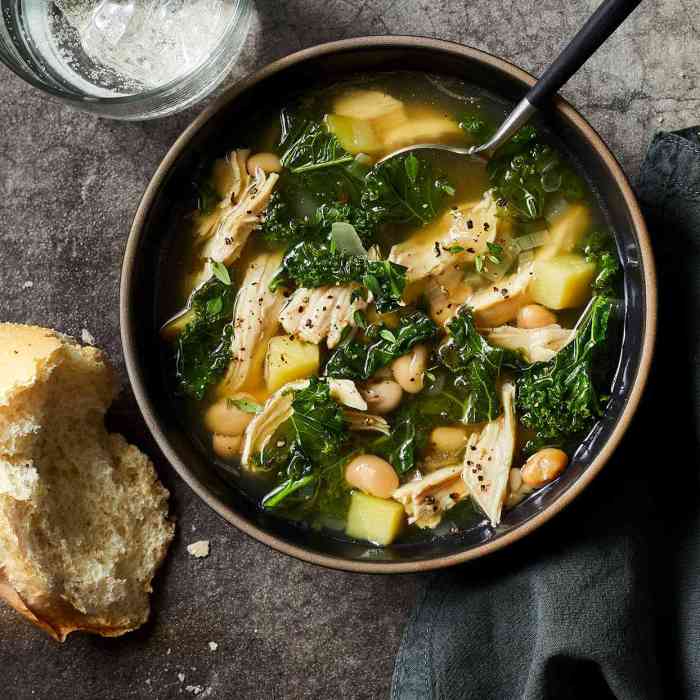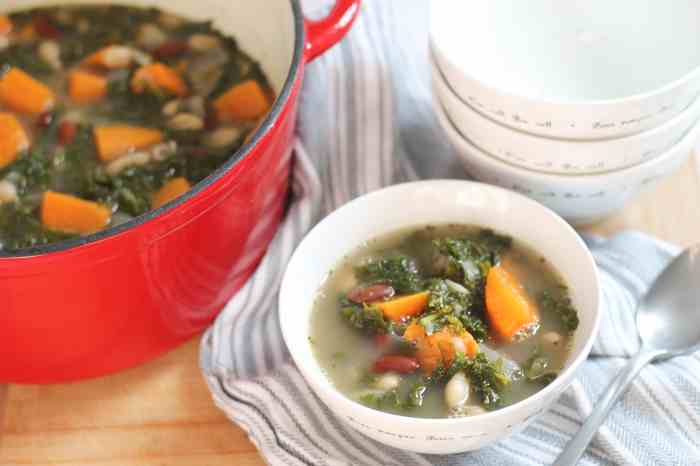Kale Soup: A Nutritious and Versatile Culinary Delight
Soup with kale recipe – Kale soup, a hearty and healthy dish, boasts a rich history spanning various cultures. While pinpointing its exact origins is difficult, kale’s inclusion in soups dates back centuries, with variations emerging across Europe and beyond. From simple broth-based recipes to creamy, ingredient-rich versions, kale soup reflects the diverse culinary traditions that incorporate this nutritious leafy green.
Nutritional Benefits of Kale

Source: tasteofhome.com
Kale, a member of the cruciferous vegetable family, is a nutritional powerhouse. It’s exceptionally rich in vitamins A, C, and K, along with minerals like potassium and calcium. Its high fiber content aids digestion, while antioxidants contribute to overall health and disease prevention. Regular kale consumption supports a healthy immune system, improves bone health, and may even help reduce the risk of chronic diseases.
The versatility of kale allows for easy integration into various diets, making it a valuable addition to a balanced nutritional plan.
Kale Soup Recipe Variations

Source: eatingwell.com
A hearty soup with kale recipe often benefits from the addition of root vegetables for extra depth of flavor. For instance, you might consider incorporating potatoes, and if you need some inspiration for potato-based soups, check out this excellent resource on soup recipes with potatoes. Returning to our kale soup, remember that the cooking time for the kale will depend on whether you’re using fresh or frozen leaves.
Three distinct kale soup styles offer diverse flavor profiles and textures. A creamy kale soup features a velvety base, often achieved with potatoes or cream, resulting in a rich and comforting dish. A chunky kale soup prioritizes texture, with larger pieces of kale and vegetables creating a satisfying bite. Broth-based kale soup emphasizes simplicity, letting the natural flavors of kale and other ingredients shine through in a lighter, more delicate soup.
| Recipe Type | Key Ingredients | Cooking Method | Taste Profile |
|---|---|---|---|
| Creamy Kale Soup | Kale, potatoes, vegetable broth, cream/coconut milk, onion, garlic | Sauté aromatics, simmer vegetables, blend for creaminess | Rich, creamy, savory |
| Chunky Kale Soup | Kale, beans (cannellini or kidney), diced tomatoes, vegetable broth, carrots, celery | Sauté vegetables, simmer until tender, add kale towards the end | Hearty, robust, slightly tangy |
| Broth-Based Kale Soup | Kale, vegetable broth, lemon juice, garlic, onion, herbs (parsley, thyme) | Simmer broth with aromatics, add kale until wilted | Light, bright, herbaceous |
Ingredient substitutions are readily available. Chicken or beef broth can replace vegetable broth for a richer flavor. Different beans, such as chickpeas or black beans, can add variety to the chunky soup. Spices like cumin, smoked paprika, or chili flakes can be adjusted to suit individual preferences.
Kale Preparation and Cooking Techniques
Proper kale preparation is essential for achieving optimal texture and nutritional value. Thoroughly washing the kale removes any dirt or debris. Chopping the kale into bite-sized pieces ensures even cooking. Wilting the kale before adding it to the soup helps to soften it without overcooking, preserving its vibrant green color and nutrients. Different cooking methods, such as sautéing or steaming, can be used to prepare kale prior to incorporating it into the soup, depending on the desired texture.
- Sauté diced onions and garlic in olive oil until softened.
- Add chopped carrots and celery; cook until slightly tender.
- Pour in vegetable broth and bring to a simmer.
- Add diced potatoes and simmer until tender.
- Stir in chopped kale and cook until wilted.
- Season with salt, pepper, and herbs (e.g., thyme, rosemary).
- Simmer for a few more minutes to allow flavors to meld.
- If desired, blend a portion of the soup for a creamier texture.
Flavor Profiles and Ingredient Combinations
The flavor of kale soup hinges on a balance of savory, acidic, and herbaceous notes. Herbs like parsley, thyme, or oregano provide a fresh, aromatic element. Spices like garlic and onion add depth and savory notes. A touch of acidity, from lemon juice or vinegar, brightens the overall flavor profile. The addition of complementary ingredients further enhances the taste.
Sausage, beans, or potatoes add richness and texture, while a sprinkle of parmesan cheese adds a salty, umami component.
- Sausage (Italian, chorizo)
- Beans (chickpeas, black beans, white beans)
- Potatoes (Yukon Gold, russet)
- Carrots
- Celery
Simmering the soup allows the flavors to develop gradually, creating a more complex and nuanced taste. Quick cooking methods, on the other hand, might result in a fresher, more vibrant flavor.
Serving Suggestions and Presentation
Kale soup can be served in various creative ways. A dollop of crème fraîche or a sprinkle of toasted nuts adds a textural contrast and enhances the visual appeal. A drizzle of olive oil and a sprinkle of freshly grated parmesan cheese add a sophisticated touch. Serving the soup in rustic bowls enhances its presentation. A crusty bread or a side salad complements the soup perfectly.
Kale soup is appropriate for various occasions, from casual weeknight dinners to more formal gatherings.
Storage and Leftovers, Soup with kale recipe

Source: theoliveblogger.com
Proper storage is crucial for maintaining the quality and freshness of leftover kale soup. Allow the soup to cool completely before storing it in airtight containers in the refrigerator. It can be stored for up to 3-4 days. Reheating can be done gently on the stovetop or in the microwave, avoiding boiling, to preserve the texture and flavor.
Freezing kale soup is also possible, extending its shelf life to several months. Remember to thaw it slowly in the refrigerator before reheating.
Essential Questionnaire: Soup With Kale Recipe
Can I use frozen kale in this recipe?
Absolutely! Frozen kale works perfectly. Just make sure to thaw it completely before adding it to the soup to prevent it from watering down the broth.
How long can I store leftover kale soup?
Stored properly in an airtight container in the refrigerator, leftover kale soup will typically last for 3-4 days.
What are some good alternatives to vegetable broth?
Chicken broth, beef broth, or even water with a bouillon cube can be used as alternatives to vegetable broth, depending on your preferred flavor profile.
Can I make this soup ahead of time?
Yes! This soup actually tastes even better the next day, as the flavors have time to meld together. Make it a day or two in advance for optimal flavor.
